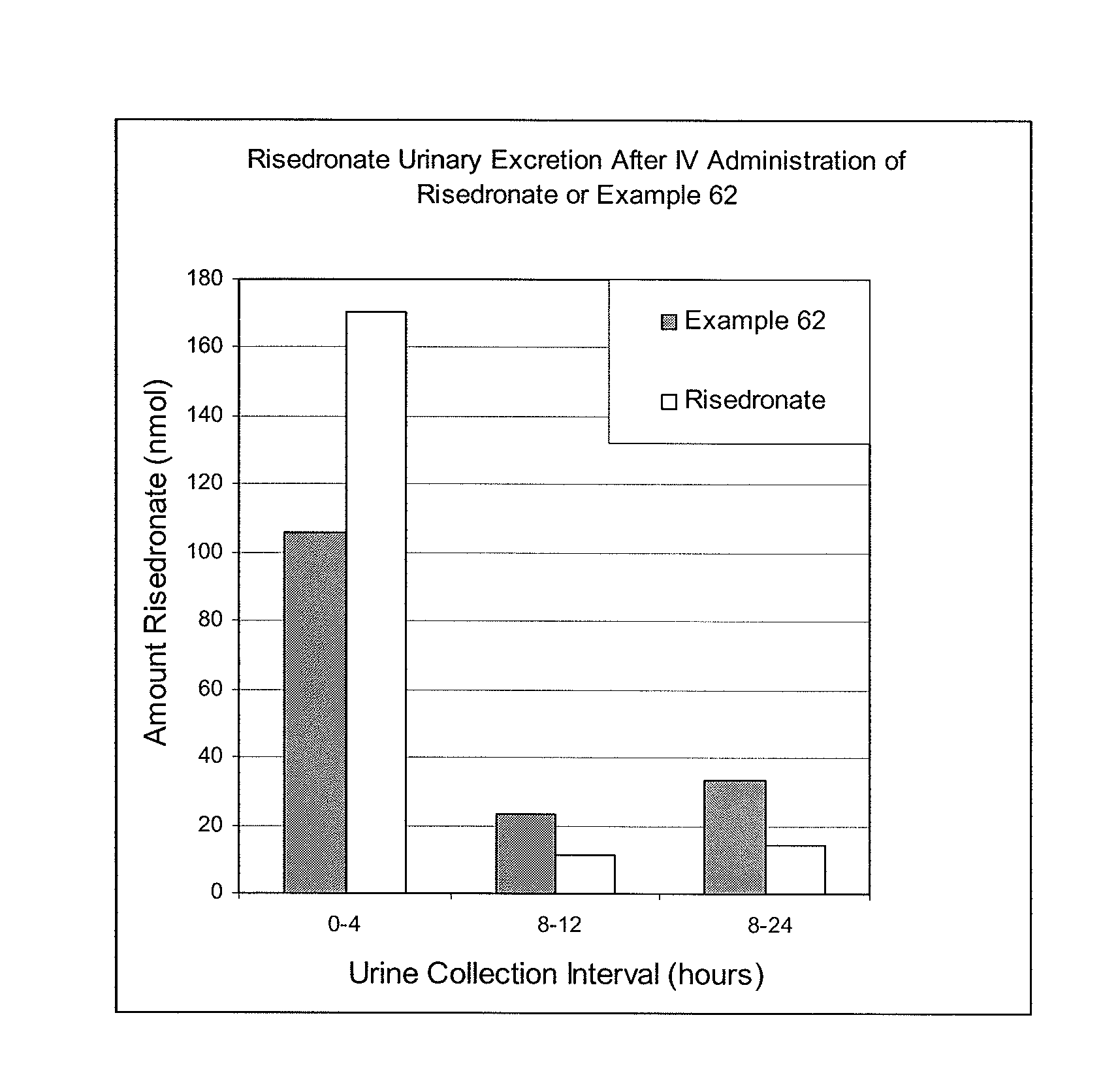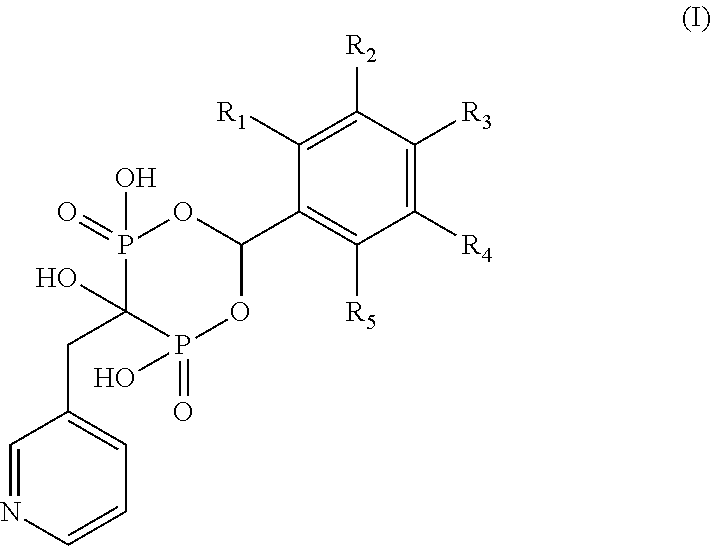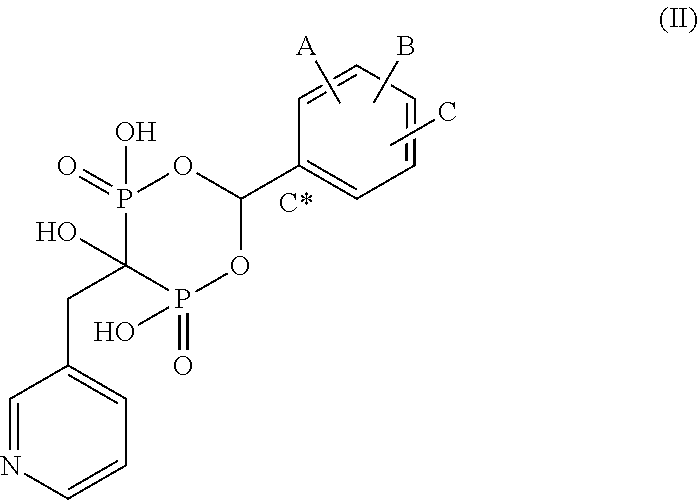Bisphosphonate compounds
a technology of bisphosphonate and compound, applied in the field of bisphosphonate compound, can solve the problems of reducing cancellous bone strength, high calcium and phosphate level, and failing to teach bisphosphonate compound cyclic acetal,
- Summary
- Abstract
- Description
- Claims
- Application Information
AI Technical Summary
Benefits of technology
Problems solved by technology
Method used
Image
Examples
example 1
4-Formylphenyl octanoate
[0361]
[0362]To a 250 mL dry round bottom flask were added 4-hydroxybenzaldehyde (6.11 g, 50.0 mmol) and anhydrous CH2Cl2 (50 mL). The solution was cooled in an ice-water bath, then pyridine (8.09 mL, 100 mmol) was added. To the resulting solution, octanoyl chloride (10.3 mL, 60 mmol) was added slowly under stirring and N2. The mixture was first stirred at 0° C. for 2 hours, then at room temperature for 20 hours. To the reaction mixture, water (100 mL) was added and the CH2Cl2 layer was separated. The aqueous layer was extracted continually with CH2Cl2 (100 mL×2). The combined CH2Cl2 solution was dried over Na2SO4. After removal of the solvent, the residue was purified with a silica gel chromatography (heptane / ethyl acetate, gradient eluting) to give 4-formylphenyl octanoate (10.7 g) as colorless oil. Yield: 86%. 1H NMR (CDCl3, 300 MHz): δ=9.98 (s, 1H), 7.91 (d, J=8.7 Hz, 2H), 7.26 (d, J=8.4 Hz, 2H), 2.58 (t, J=6.9 Hz, 2H), 1.38-0.86 (m, 13H). 13C NMR (CDCl3, ...
example 2
4-Formylphenyl isopropyl carbonate
[0363]
[0364]To a 250 mL dry round bottom flask were added 4-hydroxybenzaldehyde (4.88 g, 40.0 mmol), anhydrous CH2Cl2 (40 mL) and pyridine (4.2 mL, 52.0 mmol). The mixture was stirred in an ice-water bath, then a solution of isopropyl chloroformate in toluene (1.0 M, 48.0 mL) was added. After stirring at 0° C. for 2 hours, water (100 mL) and MTBE (300 mL) were added to the reaction mixture. The aqueous layer was separated, and the MTBE layer was washed, respectively, with cold water (80 mL), cold 5% NaOH aqueous solution (80 mL), cold water (80 mL), cold 0.5 N HCl aqueous solution (80 mL) and cold water (80 mL). The organic layer was dried over Na2SO4, and the solvent was evaporated to give 4-formylphenyl isopropyl carbonate (8.50 g) as pale yellow oil. Yield: 100%. 1H NMR (CDCl3, 300 MHz): δ=9.71 (s, 1H), 7.64 (d, J=8.4 Hz, 2H), 7.10 (d, J=8.7 Hz, 2H), 4.73 (seventet, J=6.0 Hz, 1H), 1.12 (d, J=6.3 Hz, 6H).
example 3
3,5-Difluoro-4-formylphenyl 2-oxooxazolidine-3-carboxylate
[0365]
[0366]To a 250 mL dry round bottom flask were added 2-oxazolidinone (4.35 g, 50.0 mmol), triphosgene (5.49 g, 18.5 mmol) and anhydrous THF (80 mL). The mixture was stirred in an ice-water bath, then triethylamine (9.8 mL, 70.0 mmol) was added slowly. After stirring at 0° C. for 1 hour, the mixture was stirred continually at room temperature overnight. The reaction mixture was filtered and the filtrate was concentrated. The residue was dissolved in 20 mL of CH2Cl2, and this solution was added slowly to a stirring mixture of 2,6-difluoro-4-hydroxybenzaldehyde (5.93 g, 27.5 mmol) and pyridine (4.44 mL, 55.0 mmol) in 30 mL of anhydrous CH2Cl2 at 0° C. After stirring at room temperature for 10 hours, water (100 mL) was added to the reaction mixture. The CH2Cl2 layer was separated, and the aqueous layer was extracted continually with CH2Cl2 (50 mL×4). The combined CH2Cl2 solution was dried over Na2SO4. After removal of the so...
PUM
 Login to View More
Login to View More Abstract
Description
Claims
Application Information
 Login to View More
Login to View More - R&D
- Intellectual Property
- Life Sciences
- Materials
- Tech Scout
- Unparalleled Data Quality
- Higher Quality Content
- 60% Fewer Hallucinations
Browse by: Latest US Patents, China's latest patents, Technical Efficacy Thesaurus, Application Domain, Technology Topic, Popular Technical Reports.
© 2025 PatSnap. All rights reserved.Legal|Privacy policy|Modern Slavery Act Transparency Statement|Sitemap|About US| Contact US: help@patsnap.com



